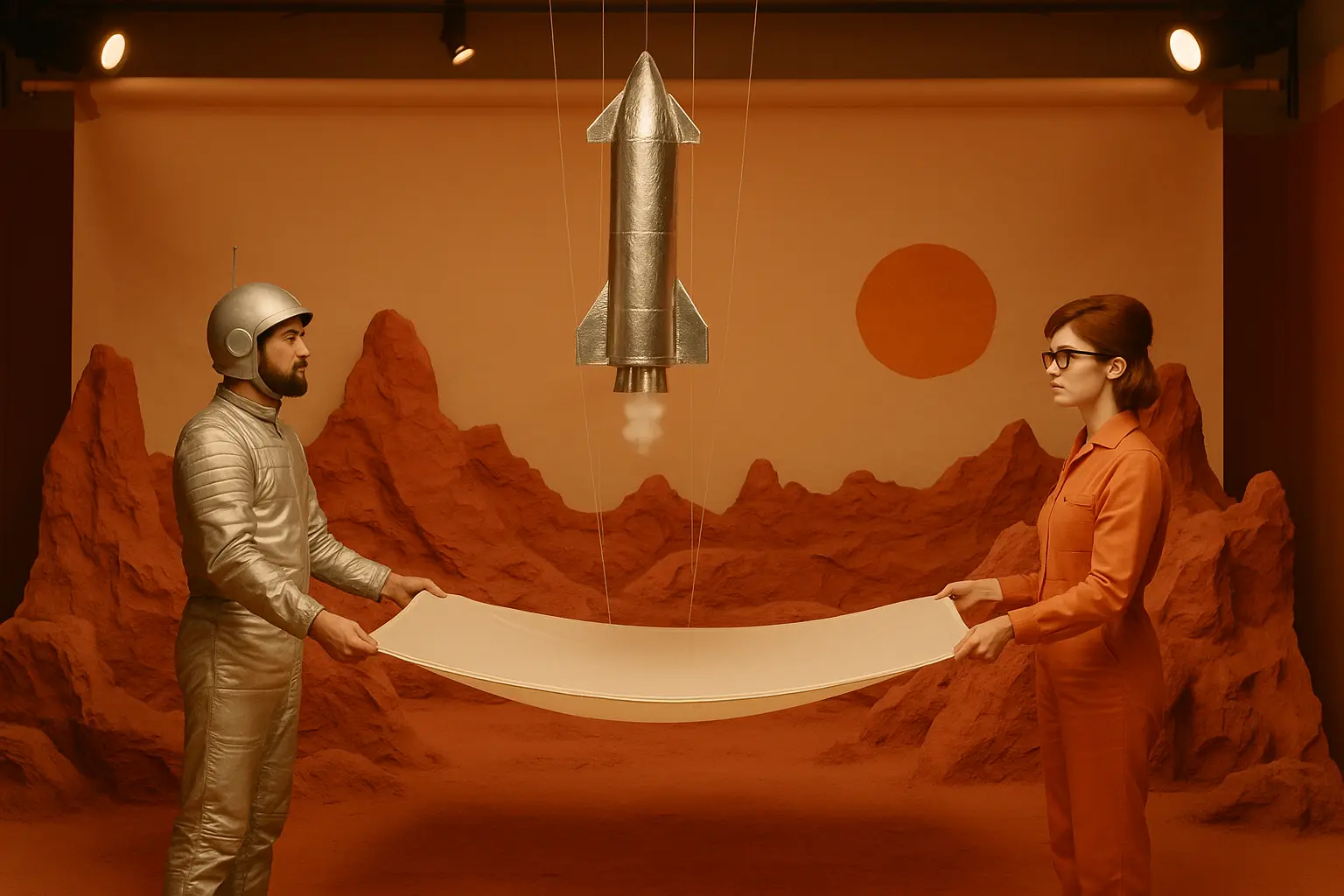Hey there, space enthusiasts and armchair astronauts! If you’ve ever watched a Falcon 9 rocket gracefully pirouette back to Earth and land on a drone ship like it’s no big deal, you might be scratching your head about SpaceX’s grander ambitions. I mean, the Starship— that gleaming stainless-steel behemoth designed to haul humanity to Mars— is supposed to colonize the Red Planet. But hold up: on Earth, these rockets have fancy concrete pads, ocean barges, and even the Mechazilla tower with its giant robotic chopsticks to catch them mid-air. Mars? It’s a barren, dusty wasteland with no infrastructure, no leveled platforms, and definitely no welcoming committee waving glow sticks. The Moon’s even worse— think fine, abrasive regolith that could sandblast your spaceship into oblivion.
So, to stupidly ask: How the heck are we supposed to land these things on alien worlds without turning them into expensive craters? Fear not! We’re diving into the nitty-gritty of SpaceX’s plans for propulsive landings on Mars and the Moon. I’ll keep it scientifically spot-on, but with a dash of humor because, let’s face it, imagining a 50-meter-tall rocket belly-flopping onto Martian soil is already comedy gold.
The Earthly Art of Landing: From Falcon 9 to Starship Shenanigans
First, let’s set the stage with what we know works on our home turf. SpaceX’s Falcon 9 has revolutionized reusable rocketry. Since its first successful landing in 2015, it’s nailed over 300 recoveries, touching down on drone ships like “Of Course I Still Love You” (yes, that’s the real name— Elon Musk’s got a flair for the dramatic) or solid ground pads. These landings rely on grid fins for steering, cold-gas thrusters for fine-tuning, and those mighty Merlin engines for the final hover-slam. The rocket essentially suicides into the atmosphere, slows down via friction and parachutes? Nah, forget parachutes— it’s all propulsive, baby. The engine reignites for a controlled descent, aiming for a bullseye on a prepared surface.
But Starship? It’s the Falcon 9’s beefier, more ambitious sibling. During its test flights from Starbase in Texas, we’ve seen prototypes perform high-altitude hops, belly-flops, and flips before landing (or, in early tests, exploding in spectacular fireballs— RUDs, or Rapid Unscheduled Disassemblies, as SpaceX calls them with a wink). The full stack— Super Heavy booster plus Starship upper stage— has now flown multiple times, with the booster even being caught by Mechazilla’s chopsticks in recent tests. This tower, with its massive arms, grabs the booster like a cosmic game of claw machine, saving wear and tear on landing legs.
These Earth-based feats are impressive, but they’re cheating a bit. We have thick atmosphere for aerobraking, GPS for navigation, and humans on-site to prep the landing zones. Mars and the Moon? They’re like trying to park your RV in the Sahara during a sandstorm— without roads, maps, or a bathroom break.
Why Alien Worlds Are a Landing Nightmare: Gravity, Dust, and No Air to Spare
Let’s get scientific (and a tad amusing) about the challenges. The Moon has no atmosphere— zip, nada. That means no aerobraking; your spacecraft plummets like a stone in vacuum. Gravity is only 1/6th of Earth’s, so things feel lighter, but that also means less forgiveness for errors— a tilt could topple your lander like a Jenga tower built by toddlers. The surface? Lunar regolith, a powdery mix of glass shards and dust from eons of meteor impacts. Apollo astronauts called it “talcum powder from hell”— it clings to everything, abrades seals, and gets kicked up by engine plumes, potentially blinding sensors or damaging nearby hardware.
Mars is trickier still. Its atmosphere is a wimpy 1% of Earth’s density, mostly CO2, so heat shields work, but parachutes? Forget it— they’re useless for heavy payloads like Starship’s 100+ tons. Gravity is about 38% of Earth’s, so landings are gentler than here but harsher than the Moon. The real kicker: Martian regolith (or soil) is fine, iron-rich dust that could be fluidized by rocket exhaust, creating craters or unstable ground. Winds, dust storms, and uneven terrain (think boulders, slopes up to 20 degrees) add to the fun. Oh, and radiation— no magnetic field means cosmic rays are partying hard.
Without concrete pads or Mechazilla, how does Starship not just sink, tip over, or blast itself into a dust cloud? Enter propulsive landing: the rocket equivalent of doing a backflip into a pool without splashing. Starship uses its Raptor engines— up to six on the upper stage— for a controlled descent. No parachutes, no skycranes (like Curiosity rover’s dramatic drop). Just raw thrust, baby.
For the Moon, SpaceX’s Starship Human Landing System (HLS) under NASA’s Artemis program is the star. It’s a modified Starship with landing legs, extra thrusters for precision, and a crew cabin. Planned for Artemis III (slated for late 2026 or beyond), it’ll dock with Orion in lunar orbit, ferry astronauts down, and lift off again.
No pad needed— the legs are wide-based, shock-absorbing struts designed to handle uneven regolith up to a certain tilt.
On Mars, the plan kicks off with uncrewed missions in 2026: five Starships launching to test entry, descent, and landing (EDL).
They’ll gather data on how the thin atmosphere affects heat shields and how engines interact with the surface. Elon Musk gives it a 50-50 shot for success by late 2026.
Crewed flights? Not till the 2030s, but the tech is the same: propulsive EDL.
Starship’s Secret Sauce: Engines, Legs, and Aerodynamic Acrobatics
Picture Starship as a silver bullet— 50 meters tall, 9 meters wide, capable of carrying 100 people or 100 tons to Mars.
Its design screams “I’m built for this!” Starting with the Raptors: these full-flow staged combustion engines run on methane and oxygen (methalox), producing insane thrust— over 230 tons each. For landing, they throttle down to 10-20% power, allowing hover-like control. Unlike Falcon’s Merlins, Raptors are optimized for vacuum and sea-level ops, with gimbaling for steering.
The landing sequence on Mars: Starship enters belly-first for max drag, flipping upright at the last moment (the famous “belly-flop” maneuver tested on Earth). Heat tiles protect against 1400°C reentry temps. Then, Raptors ignite for the suicide burn— full thrust to zero velocity just above the ground. Touchdown speed? Under 1 m/s, like stepping off a curb.
Legs are crucial. Early prototypes had fold-out legs; HLS has beefier ones for the Moon’s low gravity.
They’re not spindly Apollo-style; think wide, hydraulic dampers that absorb shock and self-level on slopes up to 15 degrees. Simulations show they can handle regolith compression— the dust compacts under thrust, forming a semi-stable base. One X post humorously notes: “It will have landing legs, but which will only need to handle ⅙th G.”
(Wait, that’s web:3, but yeah.)
For dust mitigation: Engines are positioned high, and thrust is spread out. On the Moon, HLS uses mid-body thrusters for the final 10 meters to avoid plume impingement— basically, not blasting the surface like a leaf blower in a sandbox.
Mars’ atmosphere helps disperse dust, but tests will confirm.
Amusing analogy: Imagine landing a skyscraper-sized soda can on a beach without sinking. Starship’s wide base (via legs) distributes weight like snowshoes on powder. If it tips? Built-in gyros and thrusters could right it, but prevention is key— onboard LIDAR and cameras map the site in real-time, picking safe spots.
The Devil in the Details: Challenges and How SpaceX is Tackling Them
No rose-tinted glasses here— landings could go wrong. Regolith ejection: Apollo 12’s exhaust blinded the crew; Starship’s could dig a crater. Solution? Engine plumes blow away loose dust, exposing harder substrate. Models from NASA’s PLUME project simulate this.
Tilt tolerance: Mars has hills. Starship’s legs adjust, but over 20 degrees? Abort and redirect. AI navigation, honed from Falcon droneship landings, uses terrain-relative tech to avoid hazards.
Fuel: Starship carries enough for descent, but for return? In-Situ Resource Utilization (ISRU). On Mars, it’ll make methalox from CO2 and water ice via Sabatier reactors— turning the planet’s air into rocket fuel.
Early missions will test this; future ones build pads from sintered regolith (laser-melted dust into concrete-like slabs).
Moon challenges: Vacuum means no aero help, so all propulsive. HLS has extra tanks for hover time, scanning for rocks. NASA’s CLPS precursors (like Intuitive Machines’ landers) pave the way with data.
Humor break: If Starship wobbles on landing, it’s like that drunk uncle at a wedding— legs out, thrust steady, and hope no one films the face-plant. But seriously, redundancies abound: multiple engines (if one fails, others compensate), backup sensors, and abort-to-orbit options.
From Test Flights to Terraforming: The Long Game
SpaceX’s roadmap: 2026 uncrewed Mars landings for proof-of-concept.
Then, crewed in 2031-ish, building to a city.
On the Moon, Artemis III in 2027: Starship HLS lands near the South Pole, astronauts moonwalk, collect samples.
Future infrastructure? Robots from early Starships could 3D-print pads or use regolith as ballast. Inflatable habs for crew, solar farms for power. One wild idea from X: Expendable inflatable habs for transit, jettisoned before landing.
Scientifically, this advances colonization: Proving EDL enables cargo drops, habitats, and eventually, self-sufficiency. Amusingly, it’s like pioneers in covered wagons— but the wagon lands itself and makes its own fuel.
Wrapping Up: The Audacious Leap to Multiplanetary Life
So, to answer our “stupid” question: No concrete or chopsticks needed because Starship is engineered for the wild— propulsive thrust, smart legs, and adaptive tech turn hostile worlds into parking lots. It’s not magic; it’s physics, iterated through tests and data.
This isn’t just tech porn; it’s humanity’s ticket off Earth. Falcon 9 proved reusability; Starship will prove interplanetary travel. Sure, risks abound— dust devils, engine hiccups— but as Musk says, “If things are not failing, you are not innovating enough.”
In an amusing twist, imagine aliens watching: “These humans are landing skyscrapers on our neighbor planet? Bold!” We’re on the cusp, folks. Mars awaits— no red carpet, but plenty of red dust.

